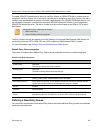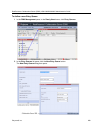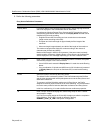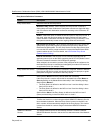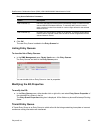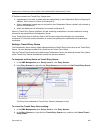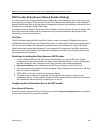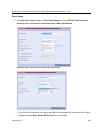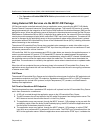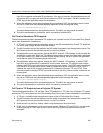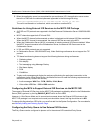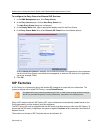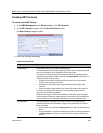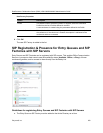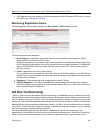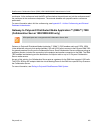
RealPresence Collaboration Server (RMX) 1500/1800/2000/4000 Administrator’s Guide
Polycom®, Inc. 295
The Cascade and Enable ISDN/PSTN Dial-in options should not be enabled with this type of
Entry Queue.
Using External IVR Services via the MCCF-IVR Package
IVR Services can be controlled externally from an application server supporting the MCCF-IVR (Media
Control Channel Framework-Interactive Voice Response) package. The external IVR service is currently
being implemented with the integration of the Polycom RealPresence Virtualization Manager (DMA) as the
application server. When the application server is deployed in the enterprise environment and the Polycom
RealPresence Collaboration Server (MCU) is deployed as a media server, the external IVR service can be
used to play audio messages, display slides, and collect DTMF input from the participant. The external IVR
service is managed by the application server at the pre-conference phase when the participant is placed
into a special external IVR-controlled Entry Queue in the Collaboration Server (MCU), collecting information
before connecting to the conference.
The external IVR-controlled Entry Queue plays recorded voice messages or sends video slides such as
splash screens to the participant and collects DTMF input from the participant such as conference ID and
conference password for various functions.
IVR media files, WAV for voice messages and JPG for video slides, are stored on the application server. In
order to provide external IVR control, a TCP-based MCCF channel is created between the application
server and the media server. Because of real-time considerations, when the MCCF channel is established,
the application server notifies the media server about the media files. The media server downloads the
media files. The media server is notified by the application server when to download new or updated media
files.
When the call has completed the pre-conference phase in the external IVR-controlled Entry Queue, the
application server disconnects the call from the Entry Queue and routes the call to an ongoing conference
or creates a new VMR.
Call Flows
The external IVR-controlled Entry Queue can be initiated for various types of calls from SIP endpoints such
as standalone endpoints and Cisco TIP endpoints. Standalone endpoints are SIP or H.264 TIP endpoints.
These endpoints can include HDX systems, multiple Telepresence (ITP) screens, and RealPresence
Desktop client applications.
Call Flow for Standalone SIP Endpoints
The following describes how a standalone SIP endpoint call is placed into the IVR-controlled Entry Queue
and is then connected to a conference:
1 A SIP call is routed through the application server to the IVR-controlled Entry Queue.
2 The MCU answers the call and waits for the IVR media file requests from the application server. The
MCU does not control the call while the call is in the Entry Queue.
3 The application server may request, through the MCCF channel - IVR package, to play an audio file
and display a slide. When the audio file has finished playing, the MCU notifies the application server
that the audio file has been played for the call.
4 The application server may request, through the MCCF channel - IVR package, to collect DTMF
input such as a conference ID or password, from the caller. The DTMF input is transferred from the
MCU to the application server. When the application server receives the DTMF input, it validates the



